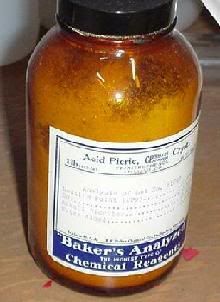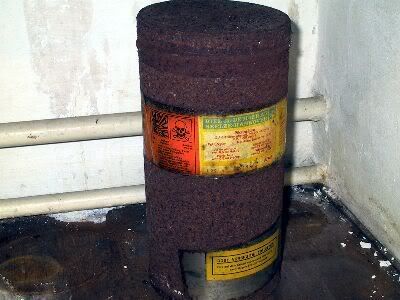What are people thinking? HazMat incident at FireHouse
I just read an article in the El Paso Times that someone took a quart bottle of Picric Acid to an El Paso Fire House on the East Side and gave it to them. Now let me think correctly... Picric Acid = Nasty Explosive if it has crystalized in the least bit. Those are shock sensitive crystals at that. Must be a sight to see your own HazMat response team come to your station which has now become the HOT ZONE in the incident. You never know what someone is going to walk up to your station with and hand off to you. Thank God it did not crystalize while with the EPFD HM team. They ended up calling a civil HM disposal service to come and take care of it.
FF Schoen
God Bless and Never Forget
Here is the link:
http://cms.firehouse.com/content/article/article.jsp?id=60762&s...
FF Schoen
God Bless and Never Forget
Here is the link:
http://cms.firehouse.com/content/article/article.jsp?id=60762&s...
Tags:
Replies to This Discussion
-
Permalink Reply by Brian Dumser on August 29, 2008 at 5:12pm
-
"There are lots of things in your local high school lab that would be cause for a hazmat incident."
I know, I just thought I would mention the Picric Acid since that's what started this discussion in the first place...lol
I'm just thinking that there could be stuff in the High School chemistry lab that was there back when you and I were in school. Depending on how often they need to re-stock a certain chemical. You just know that there's a school somewhere with crystalized Picric Acid on the shelf waiting for someone to jostle it.
-
Permalink Reply by FF Schoen on August 29, 2008 at 5:33pm
-
I completely agree with both of you Ben and Engine about leaving the explosives to the specialists who are trained to deal with it. I for one and not a bomb technician nor do we have the protection of a bomb suit. My position in this kind of situation is technical reference and intelligence gathering for the team. We would support the operation in a non bomb tech entry due to the aforementioned lack of protection. The WMD-CST would be called out to assist at the National Guard level. The Civil Support Teams are the Masters of Disasters for the miitary. We cross train with our team every year.
-
Permalink Reply by Mike Schlags (Captain Busy) Retd on August 29, 2008 at 6:52pm
-
The Firehouse article edited out from the original El Paso Times article that stated that the El Paso Fire Department had placed the 1-quart container into a 55-gallon drum filled with water. I sure hope that it wasn't actually the fire department personnel who moved this container. This is not the fire departments job to deal with explosives unless it is the fire department who has the dedicated bomb squad responsibilities like the Fort Worth Texas Fire Department. Every area is different but if there is an exothermic reaction and you are not wearing the appropriate PPE, someone is going to be asking some very specific questions. Incident commanders can be found personally liable for wrongful death suits. My assumption here is that the news article was vague, not specifying who actually moved the crystalized container.
I did a quick google on Picric Acid, looking for an example of an explosion that occurred with one of these containers, never found one, only some large ones in the 1800's or where Bomb Squads blew up the container.
The article was not specific as to the type of 1-quart container but for those of you out there that have never seen one of these containers that have crystalized picric acid, you should know that you can find two types of containers. One is pretty old... the other is REALLY old. An old glass container of Picric Acid can obviously ruin your day... A really old container of Picric Acid which was stored in a metal screw top can, well, this is one of those Houston Fire Department Hazmat Team Watchout's that they shared with me when I visited them some years back. They carry a pair of tennis shoes in the rig with their equipment to remind them that one of the appropriate options for incident mitigation is to turn around, and... RUN!

Old container of Picric Acid. Notice the crystalline structure of the dried Picric Acid on the sides of the bottle interior wall. Shock sensitive means that even a gentle nudge is enough to make the thing explode. Depending upon your distance, this may not be survivable. Memorize this picture and be very cautious when dealing with an incident involving these containers. Also, don't forget that in the event of a laboratory fire, the labels are burned off and you will have no idea what you are dealing with. Hopefully, when the materials were organized at the facility with the incident, they did so not alphabetically but by hazard class.

This is a really old container with Picric Acid. You can not see crystalline structures like the glass bottle but the rusted condition of the container is definitely one of my hazmat watch outs.
In the interest of fire and life safety, this information is shared. Please share this information with those you work with. The life you save may be your own.
TCSS, Mike Schlags, Fire Captain / Hazmat WMD Specialist
-
Permalink Reply by FF Schoen on August 29, 2008 at 7:28pm
-
Thank you for the awesome reply, information, and the pictures. That was a great addition to this topic Michael
FF Schoen
God Bless and Never Forget
-
Permalink Reply by Brian Dumser on August 29, 2008 at 9:22pm
-
Thanks Mike, I'll definitely remember that!
It almost makes me want to take a field trip to the local high school chemistry lab and look at their inventory! This might be a Fire Prevention task when inspecting the school from now on. Stay safe!
-
Permalink Reply by Ben Waller on August 29, 2008 at 9:27pm
-
Mike, great information!
Do you mind if I copy the photos for our hazmat team's training?
Ben
-
Permalink Reply by Mike Schlags (Captain Busy) Retd on August 29, 2008 at 9:52pm
-
somehow, this expression. " You just can't fix stupid! " fits this photo... don't you think?

-
Permalink Reply by Mike Schlags (Captain Busy) Retd on August 29, 2008 at 9:58pm
-
Two thoughts here Capt 723, the first is that a friend of mine in the Chicago area owns a martial arts store where he teaches kids, housewives, businessmen, anyone, that if you are ever in trouble, call the fire department... Why? because we will always be there. It's what we do and who we are. Find a rattlesnake in your house? Call the fire department. The second thought is that the stupid comment should be taken as a tongue and cheek comment, and maybe a couple of teeth thrown in... : ) We all agree, no one was stupid, people generally do things not to screw them up but instead to try and be a good citizen. We all know deep down what the right thing is to do. We just all don't have the same levels of awareness. On the next page for example, you will see actual containers of the Picric Acid. This is what you memorize and now for the rest of our career, you will not only think of Picric Acid and it's explosive hazards but the bad teeth on my hunting dogs! Failure to have a sense of humor means that you are boring to work with... Keep smiling! and of course, TCSS, Mike from Santa Barbara
-
Permalink Reply by Mike Schlags (Captain Busy) Retd on August 29, 2008 at 10:01pm
-
Ben and all that read this stuff. My purpose for posting things on the FFN is to make a difference and help everyone out. I've got lots of years doing all this stuff and it's kind of fun to share it. So in that spirit, you are welcome to use and copy any of this information for the purposes of training and not for personal profit. That's how friends treat one another. Mike from Santa Barbara
"It's all about being able to go home in the morning..."
-
Permalink Reply by Mike Schlags (Captain Busy) Retd on August 29, 2008 at 10:06pm
-
When I get the chance, I will be posting on FFN how to inspect high school labs. I was one of the authors back in the 80's for the UFC re-write for the Article 80 Committee. I taught how to do hazmat facility inspections for years and will use this format to share this stuff with everyone out there. For now, one of the secrets is classifying the hazardous material, once you know what the classifications are then it's easy to read the UFC and get directions, kind of... You need this book to do the inspections at the high school lab, or anywhere that hazardous materials are stored, used or handled in quantities requiring a fire code permit... Whoa... I still remember this stuff... : )

-
Permalink Reply by Tony P on August 30, 2008 at 9:45am
-
Just caught up with this thread - very interesting. I wonder if that stuff is used in Secondary Schools over here? I'm going to find out!
I also did a little googling on the stuff. The following phrase stood right out for me "can constitute a grave hazard". I love double meanings.
-
Permalink Reply by Park Ranger on August 30, 2008 at 11:56am
-
Some very good info guys. This reminds me
of the time we had a bomb "dropped off"
at the station one night!
- ‹ Previous
- 1
- 2
- 3
- Next ›
Specialty Websites
Find Members Fast
Firefighting Videos
© 2025 Created by Firefighter Nation WebChief.
Powered by
![]()
Badges | Contact Firefighter Nation | Privacy Policy | Terms of Service